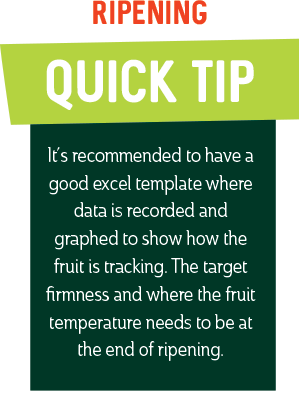Ripening Principles
There are a set of key principles which need to be considered before you attempt to ripen your kiwifruit. it comes to ripening kiwifruit - if followed correctly will
Depending on the average firmness of the fruit you intend to ripen you can use temperature (for fruit 1.5 to 3.5 Kfg) or a combination of ethylene and temperature (for fruit >3.5 Kgf). In most cases, increasing the flesh temperature of the kiwifruit should be sufficient to effectively condition the kiwifruit.
You Need to Consider the Following Factors:
1) Ability to Warm and Cool Fruit
Only consider ripening fruit if you have coolstores with strong airflow and cooling capacity. These factors are essential to prevent fruit in the centre of the pallet remaining warm post treatment. If you have limited cooling capacity, then a more conservative conditioning approach should be followed- particularly if you are close to your target firmness.
To slow ripening down its important to get the fruit temperature back down to 0°C ±0.5°C as soon as possible. Depending on the cooling capacity of your coolstore to cool the center of your pallet may take 12-24hrs+. Always keep this in mind when determining how long to leave your fruit conditioning for.
Cooling capacity Pop up - It's important to know your heating/cooling capacity by plotting the results onto a graph and drawing a heating/cooling rate curve by connecting the data points. Calculate the heating/cooling rate by dividing each temperature data point by its corresponding time data point then average all of your answers to achieve a cooling rate. In other words, the change in the temperature divided by the change in time will give you an average temperature rate change.
2) Your Supply Chain
When setting your target firmness range, it is important to consider:
Your location in the supply chain (e.g. distance to end consumer)- Consider current overall fruit firmness and the time available before delivery to retail/next business to decide whether further ripening is required or if pallets need to be held in coolstore.
The End Retail environment (display temperature and sales rates)- Depending on the temperature of the shelf display the fruit will be stored on, you will need to adjust the targeted firmness. If fruit is going onto a display shelf of 30°C instead of 20°C then you'll need to set your target firmness higher, to ensure adequate shelf life to inventory turnover.
Inventory Turnover- Is your stock moving fast or slow? The slower the turnover the more cautious you should be with the amount of fruit you choose to ripen.
3) Fruit Variability
Variability of fruit firmness within the pallet- Pallets can contain multiple grower lines, which can result in increased fruit variability in the pallet. If certain grower lines are identified as being more variable then the target firmness for the pallet may need to be higher to prevent the softer lines being over-ripened. In some cases, it may be worthwhile segregating the firmer or softer grower lines and performing separate treatments.
Sample size and selection – The larger the sample size the more representative the sample will be particularly on variable fruit. If sampling 10 fruit per grower/pallet then it's important to select fruit that gives a good representation of the grower. Selecting fruit from at least 2 to 3 packs in different locations of the pallet is recommended.
Ripening Tips
Establish ripening records – Your ripening records will become a great resource in helping you develop your ripening protocol. Different cultivars ripen at different rates, so it is worth keeping separate records for each cultivar to help you develop specific ripening models.
Start slow, learn fast – It is recommended when starting out to approach the ripening conservatively by not trying to ripen the fruit too quickly in too short a timeframe. Once experienced in ripening the approach can be pushed further.
Continually Monitor Your Fruit - As fruit ripens it's respiration rate accelerates, this causes the fruit to release more heat, further increasing its temperature. The key principle to ensuring your ripening programme is a success is continual monitoring. Frequent assessments will help you identify at what speed your fruit is moving as well as enabling you to respond quickly to any situation.
